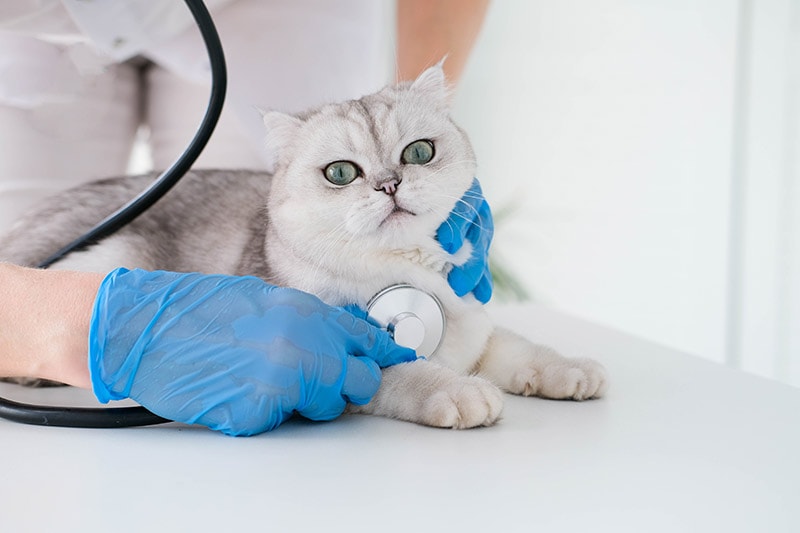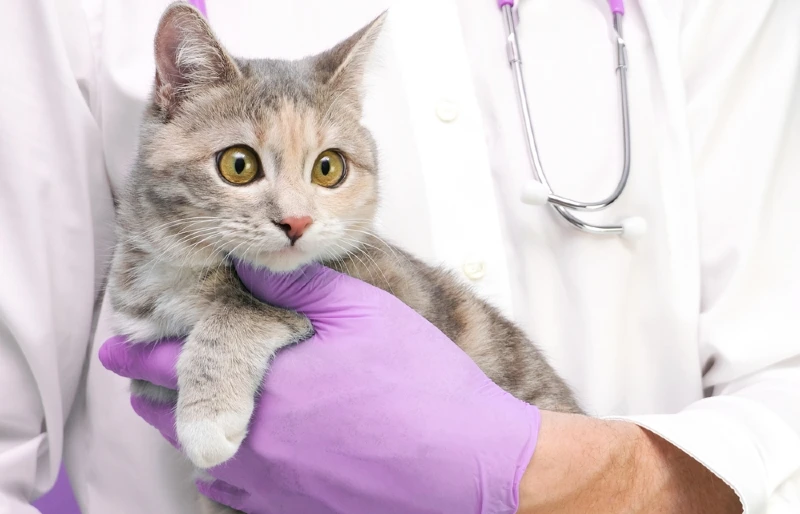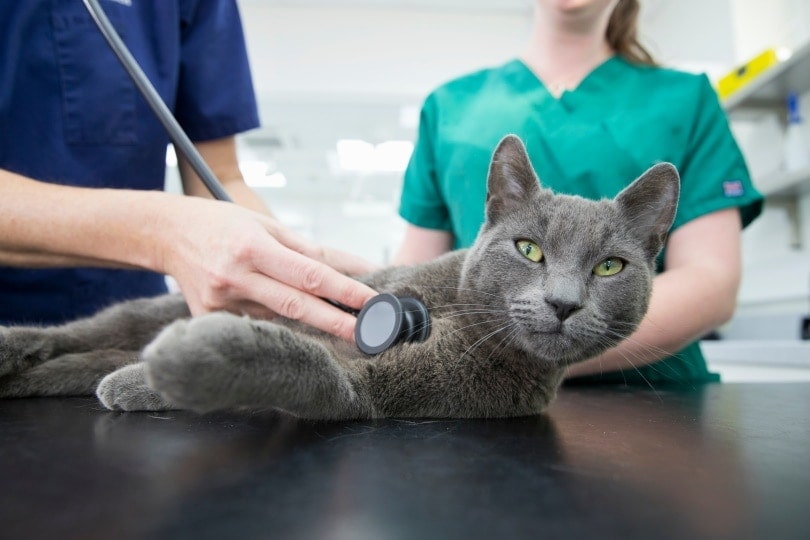When to Take Your Cat to an Emergency Vet: 8 Vet-Explained Reasons
Updated on

Realizing something is wrong with your cat is a terrifying experience. We already know they hide pain, so if you can tell something serious is happening, it can throw you into a panic.
Not everything your cat lets you see is an emergency, though, and sometimes it’s hard to tell if something is serious enough to need an ER trip if they’re still trying to hide that anything is wrong. These are the reasons to always take a cat to an emergency vet immediately.
The 8 Reasons to Take Your Cat to an Emergency Vet
1. Trauma
A seriously injured cat, such as one with a broken bone, bite wound, or another open bleeding wound, fallen from a great height, been hit by a car, is coming in from outside limping or screaming when touched, needs to see a vet immediately. You don’t want them to bleed out, develop an infection, sit in uncontrolled pain, or make anything worse. Cats in pain may be hard to handle, so be sure to transfer them into a cat carrier before leaving the house and be careful doing so.
2. Can’t Urinate
When a cat can’t pee, that’s always an emergency. In a normal cat, the bloodstream goes through the kidneys, which will pull out certain electrolytes and water volume and pass it on to the bladder as urine. They do this to filter the blood and maintain their blood volume and blood pressure. The bladder collects the urine the kidneys produce until it’s getting full, then tells the body it’s time to urinate and empty it out.
The problem is that the kidneys aren’t asking the bladder if there’s room when they pull fluid from the blood to convert to urine. There’s no feedback system. If a cat can’t pee, urine will continue to accumulate in the bladder, stretching it further and further. If that urine still can’t escape, the cat will feel pain, develop electrolyte abnormalities that can stop the heart, and, in worst cases, the bladder can rupture entirely.
Male cats are most at risk of this because their urethra is longer and often narrower, but if cats have inflammation of their urethra, the path from the bladder out of the body, or mucous or crystals accumulating in their urethra from their urine, the urethra can become blocked, keeping them from peeing.
Cats becoming blocked will go to the litter box to try to pee, but nothing comes out. You may note them crying and becoming increasingly agitated. As soon as you realize your cat is going into a litter box and nothing comes of it, they need to go straight to the ER.

3. Vomiting Repeatedly
Cats are somewhat known for vomiting, but did you know vomiting isn’t actually normal in cats and often what we call vomiting is actually regurgitating? Cats can be prone to regurgitating their food, especially if they eat too quickly or they eat dry food, which expands when it sits in their stomach.
Vomiting is usually when a cat brings up fluid such as bile, and there is a strong abdominal effort in the act rather than passively passing food back up smoothly. Vomiting once could happen to any of us, but if a cat vomits more than once in a short period, they need to get to an emergency vet ASAP. You may notice it happens a couple of times throughout the day or within an hour. Either way, they need to be seen as this can be a sign of very serious illness.
4. Sudden Weakness, Collapse, or Paralysis
When a cat is known for being spry on their feet, or at least making coordinate struts from their napping spot to their dining spot, a sudden inability to do so is always an emergency. Different underlying causes can present in different ways, but if they’re unsteady, can’t walk straight, too weak to get up, paralyzed, or collapse suddenly, they need to be rushed to the ER.

5. Seizures
Although this is a problem more prevalent in dogs, cats too can suffer from seizures. Sometimes this has to do with something that happened to them, or they can have a seizure condition, even a tumor causing it. Regardless of the reason, if this is the first time your cat has had a seizure that you know of, they cannot wait for an exam and should be seen as soon as possible. Seizing cats may bite you when you try to pick them up, completely unintentionally, so be careful handling and transporting them.
6. Respiratory Distress
You’ll rarely see a cat panting. Once in a while, a rambunctious cat that is playing will pant, or an outdoor cat moving through the heat will, but if a cat inside, at rest, is panting, that’s never a good thing. If you note your cat panting, gasping for breath, using their belly with their breaths, choking, or otherwise struggling to breathe in any way, it’s critical to get them to the closest ER as soon as you can.
Sometimes the problem is something as seemingly simple as asthma, and sometimes it’s more insidious, but any cat can pass if they can’t breathe, no matter how innocuous the underlying cause may be, so they need to get oxygen support immediately.

7. Known Exposure to a Toxin
Even if your cat isn’t acting abnormally yet, if you know they’ve come in contact with or gotten into a toxin, they need to see a vet. A quick call to the Pet Poison Helpline can help you find out if something is toxic and if your cat was exposed to enough of it to be a problem, but if the answer is yes, then they need to go to an emergency vet. If not, then they can wait for an exam with their regular vet while monitoring for any signs of illness.
8. Anorexia
Cats are special in that, if they do not eat for extended periods of time, especially if they’re overweight (which most house cats are), this can cause liver damage or even liver failure, a condition known as hepatic lipidosis. Cats that are on day two or three of not eating cannot wait any longer to see a vet and if an appointment isn’t available with your normal vet that day, then they need to go to the emergency department instead. For cats that usually have a ravenous appetite, you should be suspicious the moment they go off food and if they still don’t eat at their next meal, then it’s time to head for the ER.

Frequently Asked Questions (FAQs)
What does a cat in shock look like?
Shock can affect different parts of the body and may look like rapid breathing, rapid heart rate, which you can feel if you hold the bottom of the chest in your hand, pale gums, extreme lethargy or weakness, vomiting, possibly urinating, and even cold paws and ears.

What does respiratory distress look like in cats?
Fast breathing with obvious involvement of their abdominal muscles, crouching with the head and neck extended straight forward while coughing or gasping, pale or blue gums, blue or purple tongue, possibly extended, white foam coming from the mouth, or sudden collapse are all signs of a cat in respiratory distress.
Conclusion
In preparation for an emergency, it is best to have the information for your local veterinary ERs available on your phone, along with the contact information for the Pet Poison Helpline. If you notice any of the above signs in your cat, you should call the emergency clinic to let them know what’s going on and make sure they are taking patients (they may be above capacity) and then head straight for the clinic.
If it is daytime during normal business hours, you can also call your normal veterinary clinic first, but not all clinics are equipped for emergencies in equipment, supplies, or availability, so don’t be surprised if they advise you to go to the ER even if they’re open. If they tell you this, it’s because it’s what’s best for your pet. Emergency visits can be expensive, and it can help to apply ahead of time for payment assistance from companies such as CareCredit so you can be prepared during the visit.
Featured Image Credit: smile23, Shutterstock













